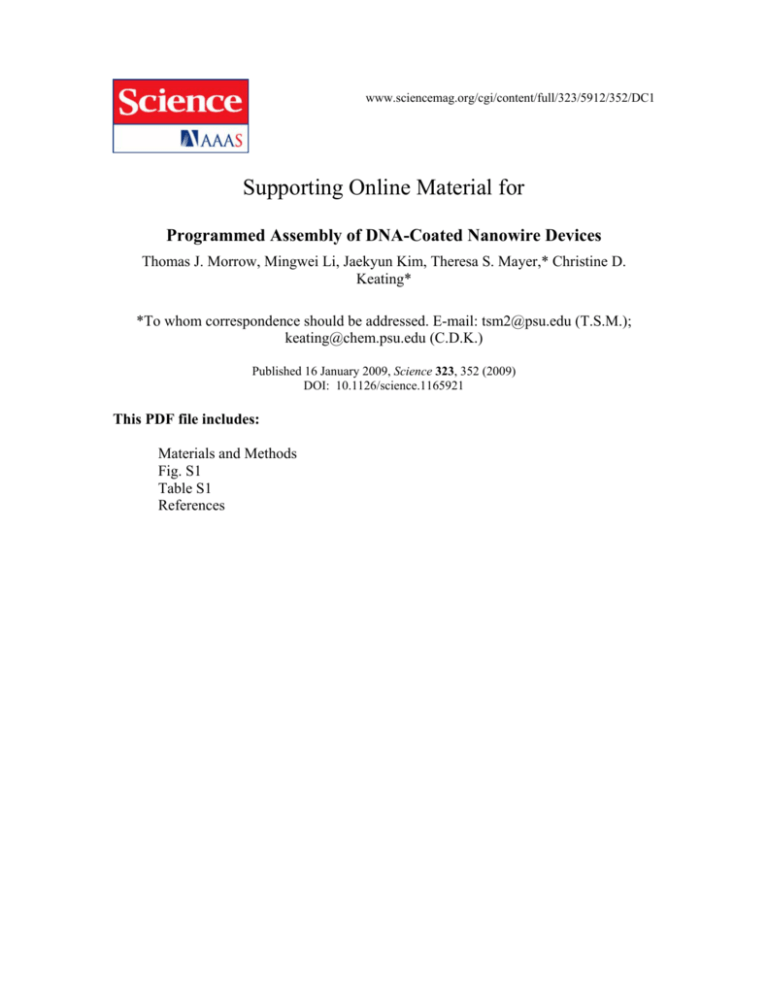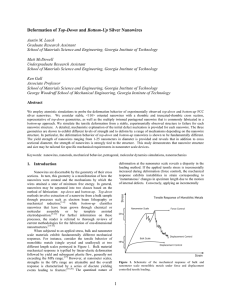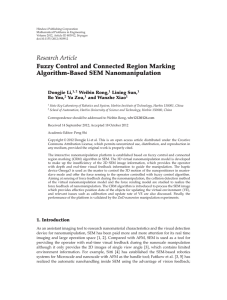supplement
advertisement

www.sciencemag.org/cgi/content/full/323/5912/352/DC1 Supporting Online Material for Programmed Assembly of DNA-Coated Nanowire Devices Thomas J. Morrow, Mingwei Li, Jaekyun Kim, Theresa S. Mayer,* Christine D. Keating* *To whom correspondence should be addressed. E-mail: tsm2@psu.edu (T.S.M.); keating@chem.psu.edu (C.D.K.) Published 16 January 2009, Science 323, 352 (2009) DOI: 10.1126/science.1165921 This PDF file includes: Materials and Methods Fig. S1 Table S1 References Supporting Online Material for Programmed assembly of DNA-coated nanowire arrays Thomas J. Morrow†, Mingwei Li#, Jaekyun Kim#, Theresa S. Mayer#*, and Christine D. Keating†* Departments of Chemistry† and Electrical Engineering#, Pennsylvania State University, University Park, PA 16802. Corresponding authors. TSM: tsm2@psu.edu; CDK: keating@chem.psu.edu This pdf file includes: Materials and Methods Fig. S1 Table S1 Materials and Methods Nanowire Synthesis and Biofunctionalization. Rh nanowires (295 ± 20 nm) were synthesized, coated with ~20 nm SiO2, and functionalized with DNA probes as previously described (1, 2). DNA-coated nanowires (~1x109 wires in 1 mL 300 mM NaCl, 10 mM phosphate buffer, pH 7.4) were then rinsed by centrifugation/resuspension 3× with 50 µL deionized water, and 3× with ethanol, finally resuspending each sample to 50 µL in ethanol. Modeling. FEMLAB software was used to simulate the dielectrophoretic force distribution of four electrode strips embedded in the photoresist layer and the aqueous solution. The gradient of the square root of the electric field (∇|E|2) represents a measure of dielectrophoretic force exerted on the polarized nanowires. Lithography and Electrofluidic Assembly. Lithographically defined electrodes (32 µm wide, 5 mm long and separated by a 3 µm gap) were fabricated by metal liftoff of 10 nm Ti, and 90 nm Au on 1 µm thermally grown SiO2 on a silicon(100) substrate. Microwells (3 x 11 µm, 20 µm pitch) were patterned ~250 nm into 1.0 µm PMGI SF-11 photoresist using previously described methods (1). Electrofluidic alignment of DNA functionalized nanowires was accomplished by applying an AC electric field (3 Vrms, 1 MHz). Nanowires functionalized with P1, P2 or P3 (Supporting Table 1), were further diluted (300-fold) with ethanol, and deposited on the substrate and positioned into the left, right, and middle microwell columns respectively, allowing the ethanol to evaporate after each set nanowires was assembled. Following nanowire assembly Au contacts were fabricated as previously described (1). Orotemp 24 RTU was electrodeposited for 15 min at -2.51 V vs Pt gauze in a two electrode system forming the Au contacts. The photoresist layers were removed by submerging the wafer in Microposit 1165 remover (15 min, 50O C), then rinsed by submerging the wafer in deionized H2O, and isopropanol and allowed to air dry. DNA hybridization and imaging. Non-specific binding to the chip was reduced by functionalizing exposed surfaces with a 5’ thiolated 10 C sequence for one hour. Hybridization of T1, T2 and T3 to their respective DNA probe molecules was performed at 0.38 µM T1, T2, and T3 in PBS at room temperature for ~36 hours, after which wafers were rinsed in PBS and a coverslip added for imaging (1.4 NA, 60x objective). Fluorescence images were acquired sequentially at each chip location, and were false-colored and overlaid for viewing (Alexa488 = blue, Alexa647 = red, and TAMRA = green). Supporting Figure 1. Control in which DNA-coated nanowire populations were mixed prior to assembly onto the chip. Wires carrying different probe sequences are randomly distributed between the columns of microwells. Scale bar = 10 µm. Supporting Table 1 a Name Sequence 5’3’ Description P1 Thiol- TTTTTTTTTTGAGTAGTGTTGGGTCGCGAA HCVa Probe P2 Thiol- TTTTTTTTTTCCATCAATGAGGAAGCTGCA HIVb Probe P3 Thiol-TTTTTTTTTTCTCAATCTCGGGAATCTCAA HBVc Probe T1 Alexa Fluor 488- TTCGCGACCCAACACTACTC HCV Target T2 Alexa Fluor 647-TGCAGCTTCCTCATTGATGG HIV Target T3 Tamra-TTGAGATTCCCGAGATTGAG HBV Target HCV = hepatitis C virus; b HIV = human immunodeficiency virus, c HBV = hepatitis B virus. References (1) M. Li et al. Nature Nanotechnol. 3, 88 (2008). (2) J. Sioss et al. Langmuir 23, 11334 (2007).








